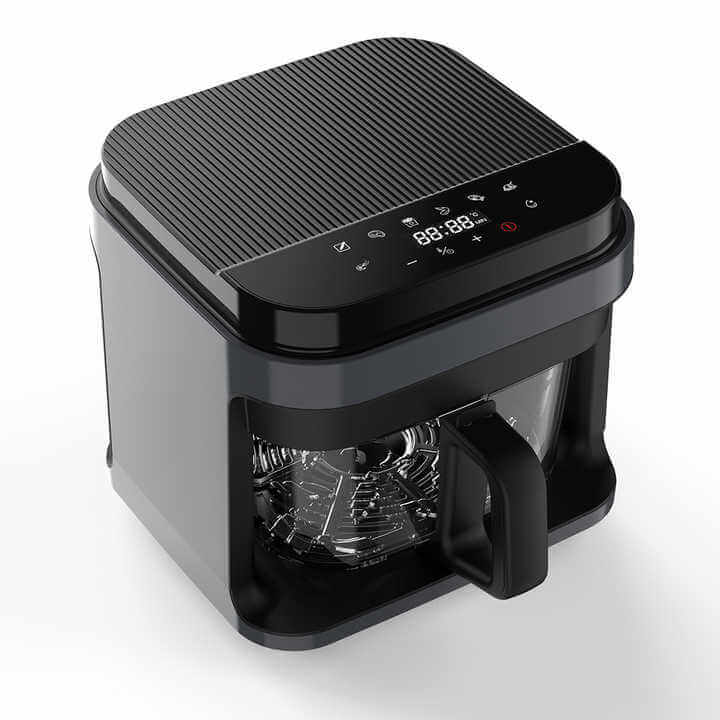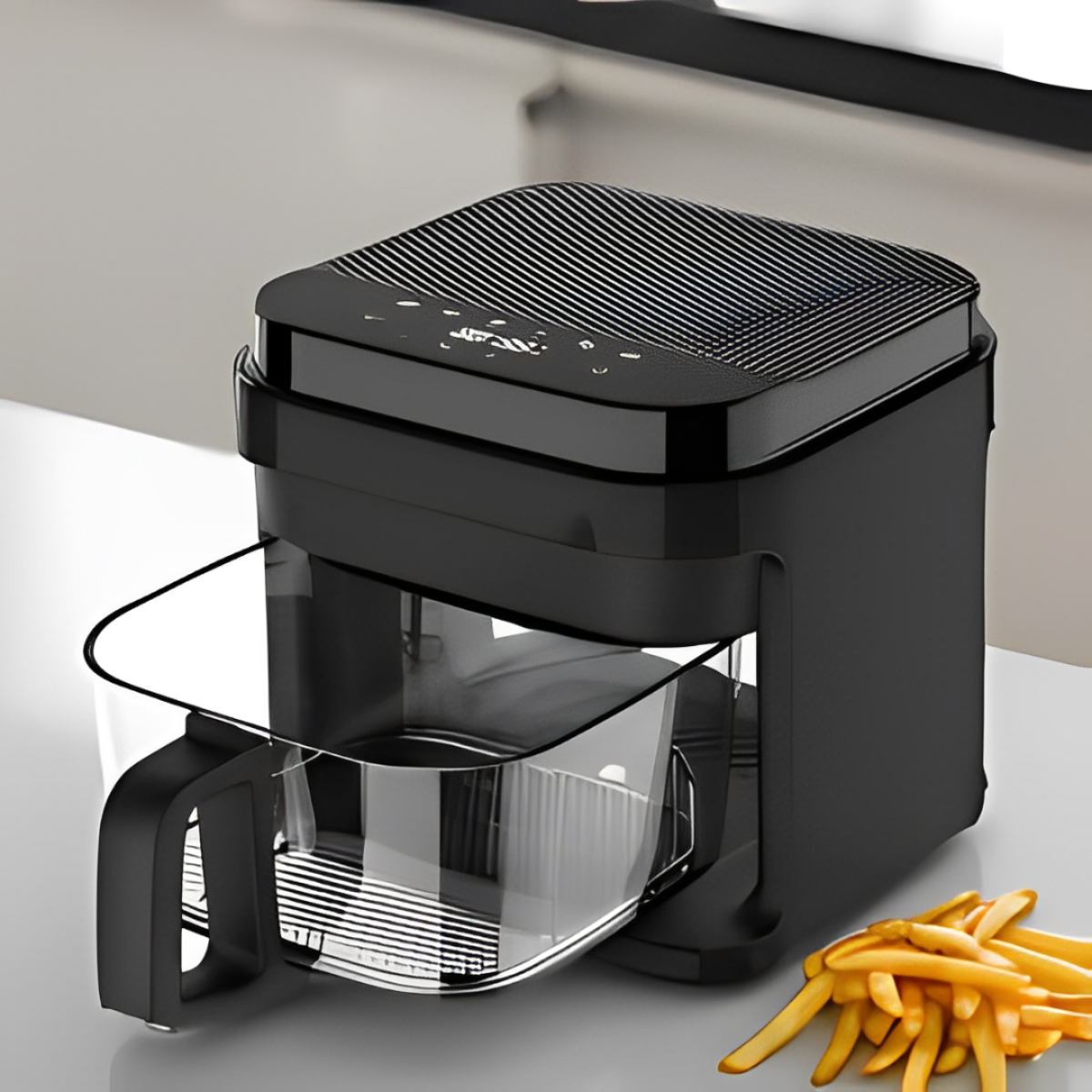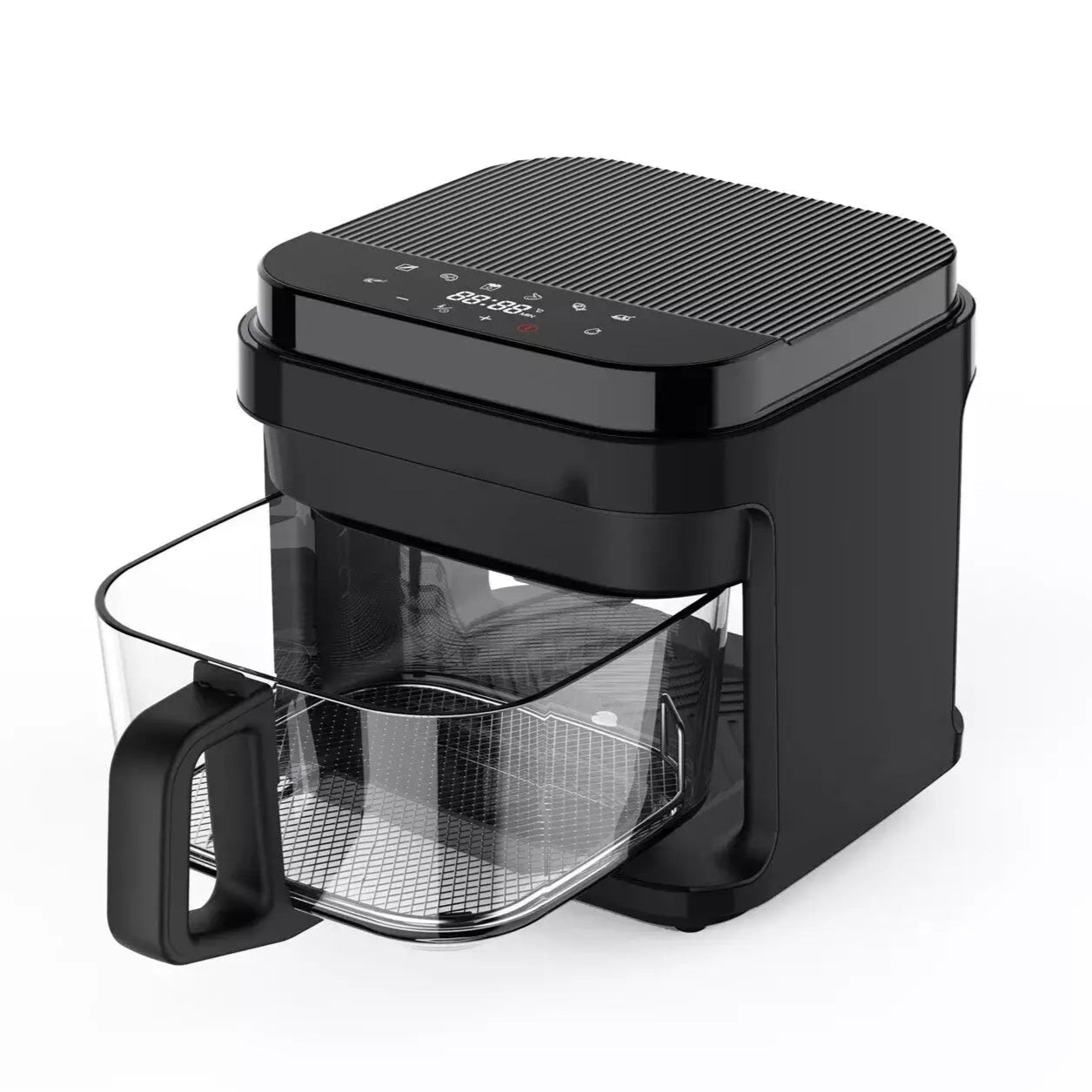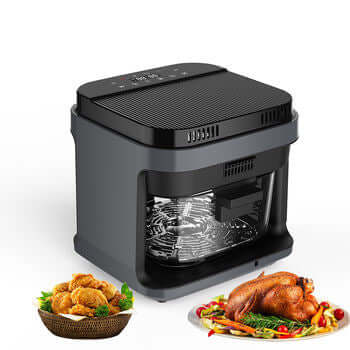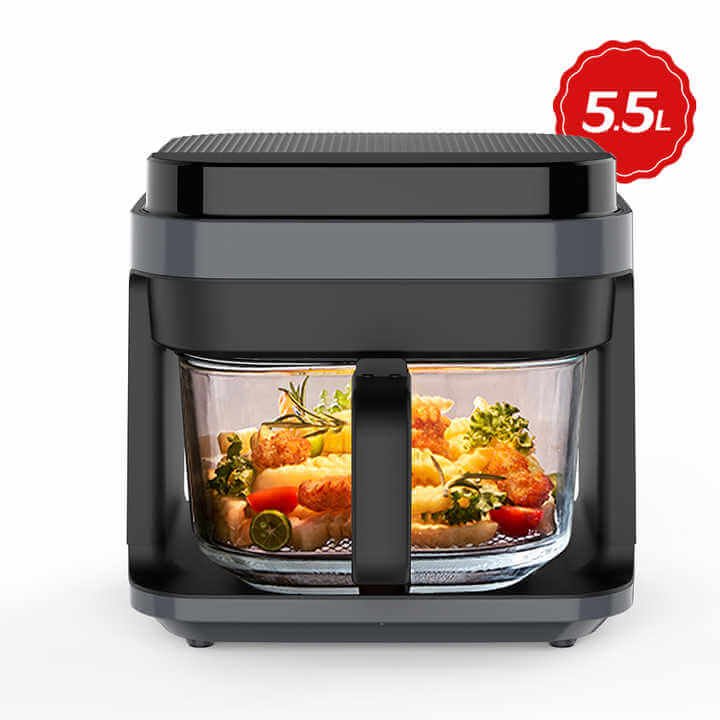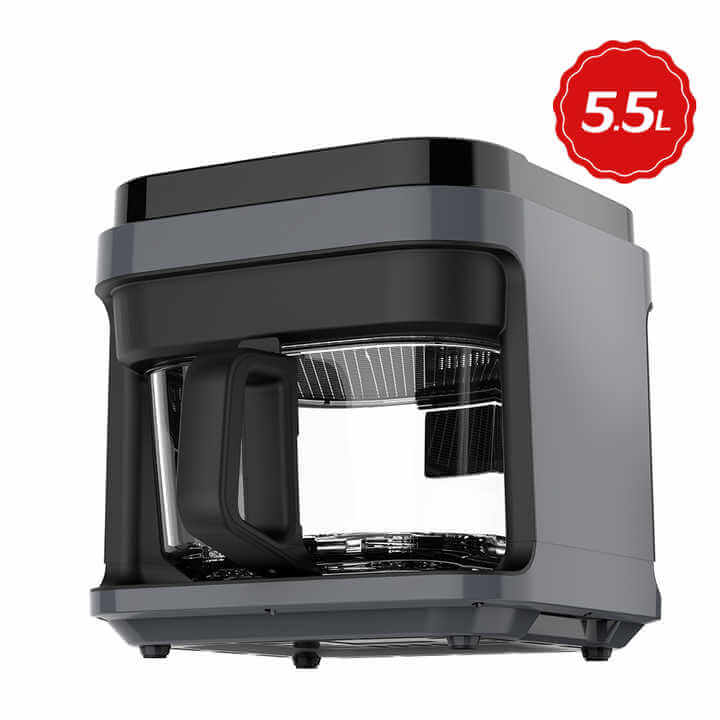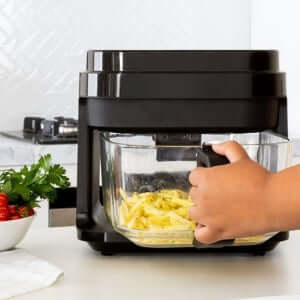Glass vs. Ceramic vs. Stainless Steel: What's the Best Non-Toxic Air Fryer Material?
What’s the best non-toxic air fryer material in Australia—glass, ceramic, or stainless steel? In Australia, glass air fryers are the safest non-toxic choice, being completely inert, PFAS-free, and easy to clean. Ceramic is a strong PFAS-free alternative with excellent non-stick properties, while stainless steel offers unmatched durability. For health-conscious Aussie families, glass air fryers like the Terra Wellness 5.5L deliver the best balance of safety, performance, and longevity.
When it comes to choosing a non-toxic air fryer, the material it's made from is the most important consideration. The three most common non-toxic materials are glass, ceramic, and stainless steel. Each has its own unique set of pros and cons, and the best choice for you will depend on your individual needs and preferences.
In this article, we'll take a deep dive into each of these materials, comparing them on a range of factors including safety, durability, and ease of use. We'll also provide you with some tips on how to choose the right non-toxic air fryer for your kitchen.
Glass Air Fryers: The Clear Choice for Health-Conscious Cooks
Glass air fryers have become increasingly popular in recent years, and for good reason. Glass is an inert material, which means it won't react with your food or release any harmful chemicals when heated. This makes it one of the safest materials you can use for cooking.
One of the biggest advantages of a glass air fryer is its transparency. Being able to see your food as it cooks allows you to monitor its progress and ensure it's cooked to perfection. This is especially useful when you're trying out a new recipe or cooking something delicate that can easily burn.
In terms of cleaning, glass is a dream. It's non-porous and naturally non-stick, so food doesn't tend to stick to it. Most glass air fryer bowls are also dishwasher safe, making cleanup a breeze.
When it comes to durability, not all glass is created equal. Look for an air fryer that uses high-quality borosilicate glass, like the Terra Wellness 5.5L Glass Air Fryer. Borosilicate glass is resistant to thermal shock, which means it can withstand high temperatures without cracking or breaking.
•Completely non-toxic and inert
•Transparent for easy monitoring
•Easy to clean and dishwasher safe
•Durable and resistant to thermal shock (borosilicate glass)
•Can be heavier than other materials
•Potential for breakage if dropped
Ceramic Air Fryers: A Non-Stick Alternative
Ceramic air fryers are another excellent non-toxic option. They are coated with a ceramic non-stick layer that is free from PFAS, PFOA, and PTFE. This makes them a safe and healthy alternative to traditional non-stick air fryers.
One of the main advantages of ceramic is its excellent non-stick properties. Food slides right off, making it easy to cook with and clean. Ceramic is also scratch-resistant, so you don't have to worry about damaging the surface with metal utensils.
However, there are a few downsides to ceramic. The non-stick coating can degrade over time, especially if it's not properly cared for. It's also more prone to chipping and cracking than glass or stainless steel.
•Non-toxic and free from PFAS, PFOA, and PTFE
•Excellent non-stick properties
•Can chip or crack over time
•Non-stick properties may degrade with use
Stainless Steel Air Fryers: The Durable Workhorse
Stainless steel is a popular choice for cookware, and for good reason. It's durable, long-lasting, and non-reactive, making it a safe and reliable option for cooking.
One of the biggest advantages of stainless steel is its durability. It's resistant to scratches, dents, and corrosion, so it will last for years to come. It's also non-reactive, so it won't leach any harmful chemicals into your food.
However, stainless steel is not naturally non-stick. This means you may need to use more oil or be more careful when cooking to prevent food from sticking. It can also be more difficult to clean than glass or ceramic.
•Durable and long-lasting
•Non-reactive and safe for cooking
•Can be used at high temperatures
•Can be more difficult to clean
The Science Behind Non-Toxic Materials
Understanding why certain materials are safer than others requires a basic knowledge of chemistry and how different substances react when heated. Traditional non-stick coatings are made from synthetic polymers that can break down at high temperatures, releasing potentially harmful compounds into the air and onto your food.
In contrast, glass, ceramic, and stainless steel are all considered chemically inert materials. This means they don't react with food or release harmful substances when heated, making them inherently safer choices for cooking.
Borosilicate Glass: The Gold Standard
Not all glass is created equal when it comes to cookware. The best glass air fryers use borosilicate glass, which contains boron trioxide. This addition makes the glass more resistant to thermal shock, meaning it can withstand rapid temperature changes without cracking or breaking.
Borosilicate glass has a lower coefficient of thermal expansion than regular soda-lime glass, which is why it's used in laboratory equipment and high-end cookware. When you see an air fryer advertised as having "laboratory-grade glass," this is typically what they're referring to.
The Terra Wellness 5.5L Glass Air Fryer uses premium borosilicate glass that can safely handle the rapid heating and cooling cycles typical in air frying. This makes it not only safer from a chemical standpoint but also more durable and long-lasting.
Ceramic Coatings: Understanding the Technology
Ceramic coatings used in air fryers are typically made from silicon dioxide (silica) and other natural minerals. These coatings are applied to a metal base, usually aluminum, through a process called sol-gel coating.
The advantage of ceramic is that it provides excellent non-stick properties without the use of PFAS chemicals. However, the quality of ceramic coatings can vary significantly between manufacturers. Look for air fryers that specify they use "pure ceramic" or "100% ceramic" coatings, as some manufacturers use ceramic-infused coatings that may still contain other chemicals.
One thing to keep in mind with ceramic coatings is that they can be more fragile than glass or stainless steel. They're prone to chipping if dropped or if metal utensils are used on them. However, when properly cared for, a high-quality ceramic coating can last for many years.
Stainless Steel: The Industrial Standard
Stainless steel is an alloy made primarily of iron, chromium, and nickel. The chromium content (typically 10.5% or higher) is what gives stainless steel its corrosion resistance and makes it "stainless."
For cookware, the most common grades are 304 and 316 stainless steel. Grade 304 contains 18% chromium and 8% nickel, while grade 316 contains 16% chromium, 10% nickel, and 2% molybdenum. Both are considered food-safe and non-reactive.
The main advantage of stainless steel is its durability. It's virtually indestructible under normal use conditions and can handle high temperatures without any degradation. However, stainless steel is not naturally non-stick, which means you may need to use more oil or be more careful about cooking techniques to prevent sticking.
Detailed Comparison: Performance Characteristics
Heat Distribution and Retention
Glass: Borosilicate glass has excellent heat retention properties, meaning it stays hot longer after the heating element turns off. This can be beneficial for foods that benefit from continued cooking, but it also means you need to be careful about overcooking. Glass heats evenly, reducing hot spots that can cause uneven cooking.
Ceramic: Ceramic coatings heat up quickly and distribute heat evenly across the surface. They also retain heat well, though not quite as much as glass. The even heat distribution makes ceramic excellent for delicate foods that can easily burn.
Stainless Steel: Stainless steel heats up quickly but doesn't retain heat as well as glass or ceramic. This can actually be an advantage for foods where you want precise temperature control. However, stainless steel can develop hot spots if the base isn't thick enough or if it's not properly constructed.
Cleaning and Maintenance
Glass: Glass is the easiest material to clean because it's completely non-porous. Food doesn't stick to it, and any residue can be easily removed with warm soapy water. Glass is also dishwasher safe and won't retain odors or flavors from previous cooking sessions.
Ceramic: Ceramic is also relatively easy to clean, especially when new. However, over time, the non-stick properties can diminish, making cleaning more difficult. Ceramic can also stain more easily than glass, particularly with foods that have strong colors like turmeric or tomato sauce.
Stainless Steel: Stainless steel requires more effort to clean, especially if food sticks to it. However, it's virtually indestructible, so you can use abrasive cleaners or scrubbers if necessary. Stainless steel won't stain or retain odors, and it's dishwasher safe.
Longevity and Durability
Glass: High-quality borosilicate glass can last for decades with proper care. The main risk is breakage from dropping or extreme temperature shock, but under normal use conditions, glass air fryer bowls are extremely durable.
Ceramic: The lifespan of ceramic coatings varies widely depending on quality and use. High-end ceramic coatings can last 3-5 years with regular use, while lower-quality coatings may start to degrade within a year. Proper care can significantly extend the life of ceramic coatings.
Stainless Steel: Stainless steel is the most durable option and can literally last a lifetime with proper care. It won't chip, crack, or wear out, making it an excellent long-term investment.
Health Considerations: Beyond Just "Non-Toxic"
While avoiding PFAS chemicals is important, there are other health considerations when choosing an air fryer material:
Allergen Considerations
Some people may have sensitivities to nickel, which is present in stainless steel. While this is relatively rare, it's something to consider if you have known metal allergies. Glass and ceramic are hypoallergenic and won't cause reactions in sensitive individuals.
Microplastic Concerns
Recent research has raised concerns about microplastics in our food supply. While air fryers don't typically contain plastic in the cooking chamber, some models may have plastic components that could potentially contribute to microplastic contamination. Glass and ceramic air fryers eliminate this concern entirely.
Heavy Metal Leaching
Some ceramic glazes, particularly those made overseas with less stringent quality controls, may contain heavy metals like lead or cadmium. When choosing a ceramic air fryer, look for products that are certified lead-free and cadmium-free by reputable testing organizations.
Environmental Impact and Sustainability
The environmental impact of your air fryer choice extends beyond just the materials used in construction:
Manufacturing Footprint
Glass: The production of borosilicate glass requires high temperatures and significant energy input. However, glass is 100% recyclable and can be recycled indefinitely without loss of quality.
Ceramic: Ceramic production also requires high-temperature firing, making it energy-intensive. However, ceramic is made from abundant natural materials and is also fully recyclable.
Stainless Steel: Stainless steel production is energy-intensive and requires mining of various metals. However, stainless steel is highly recyclable and retains its properties through multiple recycling cycles.
End-of-Life Disposal
When your air fryer eventually reaches the end of its useful life, the material it's made from determines how it can be disposed of:
•Glass can be recycled indefinitely
•Ceramic can be recycled but may require special facilities
•Stainless steel is highly valuable for recycling and is widely accepted
Making the Right Choice for Your Kitchen
Choosing the best non-toxic air fryer material depends on your specific needs, preferences, and cooking style:
Choose Glass If:
•You prioritize absolute safety and non-toxicity
•You want to monitor your food while it cooks
•You prefer easy cleanup and maintenance
•You don't mind a slightly heavier appliance
•You want the longest-lasting option
Choose Ceramic If:
•You want excellent non-stick properties
•You prefer lighter-weight appliances
•You're comfortable with more careful handling
•You want a good balance of performance and safety
Choose Stainless Steel If:
•You prioritize maximum durability
•You don't mind using more oil or careful cooking techniques
•You want the most environmentally sustainable option
•You prefer industrial-grade construction
Conclusion: The Clear Winner for Health-Conscious Cooks
While all three materials offer significant advantages over traditional non-stick coatings, glass emerges as the clear winner for health-conscious consumers. The combination of complete chemical inertness, transparency for monitoring food, easy cleaning, and long-term durability makes glass air fryers like the Terra Wellness 5.5L Glass Air Fryer the ideal choice for families who prioritize health and safety.
The investment in a high-quality glass air fryer pays dividends in terms of peace of mind, cooking performance, and longevity. When you choose glass, you're not just buying an appliance—you're investing in your family's health and well-being for years to come.
Remember, the best air fryer is the one you'll actually use regularly. Whichever material you choose, make sure it fits your cooking style, kitchen setup, and maintenance preferences. The most important thing is moving away from traditional non-stick coatings and embracing safer, non-toxic alternatives that will serve you and your family well for years to come.






